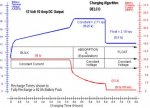malachi constant
Senior Member
- Location
- Minneapolis
I am designing a double tub panel that feeds 64 15A/1P receptacles. The receptacles feed battery charging equipment for a golf cart storage area. The manufacturer says to assume a 12A load, but that it will gradually taper off to get down to ~0A after 12 hours. It's theoretically possible but highly unlikely that all 64 golf carts would be fully discharged and get plugged in at the same time.
The NEC requires you use 180VA a receptacle, to which a demand factor of 0.50 is applied after the first 10kVA. I don't think this applies here, but can't figure out what does. It requires you use a different set of demand factors for motors, electric heat, lighting, etc. What about equipment like this?
A. Could I classify it as a 180VA receptacle? (I wouldn't, even if it let me.)
B. As a continuous load with 1.25 factor applied to each receptacle? (I don't think "continuous" applies, but don't know batteries that well, maybe it does?)
C. As a non-continuous load with 1.00 factor applied to each receptacle? (This is where I'm at now.)
D. As a motor with a factor of 1.25 applied to the first receptacle and 1.00 to each thereafter?
E. Can I apply a demand factor less than 1 to reflect the fact that these are highly unlikely to all be used at full load at the same time (similar to demand factors allowed for multiple elevators, multiple kitchen equipment, etc)?
Right now I am assuming a demand factor of 1.00 for each 12A load. 12A x 120V x 64 = 92kVA. 92KVA / 208V / SQRT(3) = 256A. Is this the load you would use to size the panel, and plug it into the overall service calcs? So 400A panel?
Thoughts are appreciated. Thanks!
The NEC requires you use 180VA a receptacle, to which a demand factor of 0.50 is applied after the first 10kVA. I don't think this applies here, but can't figure out what does. It requires you use a different set of demand factors for motors, electric heat, lighting, etc. What about equipment like this?
A. Could I classify it as a 180VA receptacle? (I wouldn't, even if it let me.)
B. As a continuous load with 1.25 factor applied to each receptacle? (I don't think "continuous" applies, but don't know batteries that well, maybe it does?)
C. As a non-continuous load with 1.00 factor applied to each receptacle? (This is where I'm at now.)
D. As a motor with a factor of 1.25 applied to the first receptacle and 1.00 to each thereafter?
E. Can I apply a demand factor less than 1 to reflect the fact that these are highly unlikely to all be used at full load at the same time (similar to demand factors allowed for multiple elevators, multiple kitchen equipment, etc)?
Right now I am assuming a demand factor of 1.00 for each 12A load. 12A x 120V x 64 = 92kVA. 92KVA / 208V / SQRT(3) = 256A. Is this the load you would use to size the panel, and plug it into the overall service calcs? So 400A panel?
Thoughts are appreciated. Thanks!

